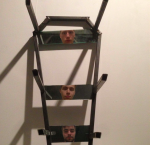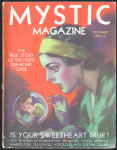Writer-director Ti West and his film, The Sacrament, are coming to the IU Cinema as part of the Diabolique International Film Festival ● by Max Weinstein
[
The Diabolique International Film Festival is a celebration of independent horror, science fiction, and dark fantasy film. In its eighth year, DIFF will take place from September 18-20 at the IU Cinema.
As a film festival, DIFF acts as a platform for independent genre films and filmmakers that work to explore possibilities outside of studio constraints. The DIFF Academic Symposium also aims to generate discussion about independent and alternative horror. The horror genre has circulated for years through alternative means including foreign film, art film, independent film, and tonal intersections with a variety of other genres; these are the alternatives DIFF celebrates. The scope of the DIFF symposium is broad yet specific: to discuss the possibilities and future of horror film, or films that intersect with horror, outside of those produced by major studios, exploring the complexities and potential of the genre when unrestricted by Hollywood limitations. For more on DIFF visit diaboliquefilmfestival.com
A version of this article was originally published in Diabolique magazine.]
“In a perfect world, I would have done an eight-part documentary mini-series about Jonestown,” Ti West explains when considering what could have been made in lieu of The Sacrament, his latest film that, with some struggle, he resolves to describe as a “sort of new media type thing.”
The Sacrament is a great horror film ⎯ a film whose media meshing invokes a necessary discourse on the representation of reality in a genre designed to shock and affect. West’s most complete and ambitious work to date deftly interweaves a multiplicity of techniques, aesthetics and subgenres to tell the story of the mysterious Eden Parish, a People’s Temple-esque cult that becomes the focal point of The Sacrament’s film-within-a-film fictional investigative documentary.
Kentucker Audley co-stars as Patrick, a photo journalist who gains access to Eden Parish, intending to meet his sister Caroline (Amy Seimetz), who has been a member of the commune since being taken in for drug therapy by its leader, Charles Anderson Reed (Gene Jones). In tow are two of Patrick’s colleagues from Vice Media, Sam (AJ Bowen) and Jake (Joe Swanberg). As Reed, the enigmatic leader of Eden Parish known to his followers simply as “Father,” Gene Jones delivers a performance whose potency is the catalyst for The Sacrament’s blurring of ethical journalism and individual moralism; Sam unnerves viewers when he tells Jake, on-screen, that while he wouldn’t choose to live a life at Eden Parish, his immersion in its daily goings-on are allowing him to actually “dig it.”
“That line is a big thesis line of the movie,” West asserts. “What I wanted to show when they got there and saw this place was that it’s weird — it’s definitely weird — but, ‘Hey, if they wanna live like this, if nothing’s wrong, who am I to say otherwise?’ People think that if you’re in a cult, 24/7, you’re just a lunatic every minute of every day. Hopefully the first half of the movie can help educate people to a certain extent, to where they see these people and go, ‘Oh. I understand why they’re here. I don’t wanna do that. But it makes sense, what they’re saying.’ [In] the big interview with Father, it’s all there. Everything he’s saying doesn’t sound so bad.”
Parallels between Father’s diatribes against America’s social, political and economic status quo and Jim Jones’ rationale for coaxing Jonestown members to commit mass “revolutionary suicide” are of primary concern to West in his efforts to school modern audiences on doomsday cults’ hive mentality. “Ideologically, everything he says should make perfect sense to everybody,” West says of Father’s delusional hijacking of serious systemic ills like imperialism, racism, or homelessness. “Like, ‘We shouldn’t have poor people!’ ‘I agree.’ ‘We shouldn’t have sick people!’ ‘I agree.’ He’s saying such basic things. Now, if you’re in a very desperate situation that you can’t improve, and a guy comes along and says, ‘Come with me and I can make your life better,’ you’d try it. Maybe it works, maybe it doesn’t work. But to get it to work, you stick with it. For a while it is better than the life you had before. But the bigger that group gets, as always, the megalomaniac who’s in charge starts to pervert it. The guy promises everything — great — gives you some of it, and once you’re so deep in, you realize it’s not all there and there’s nothing you can do about it, because your life has become so insular. You’re too in it now.”
The name Eden Parish in and of itself appropriates biblical connotations to slyly suggest not only the “new beginning” Father promises its members, but also the eradication of one’s sense of self that his benevolent-seeming brainwashing gradually creates, in the name of a “fresh start.” West’s voice grows agitated when explaining Father’s theft of the cult’s members’ identity, as if arguing with an imaginary person whose perspective is noxiously contrarian to that of his own: “Even when you go back to Jonestown, it’s like: ‘I wouldn’t have taken the poison!’ How? How would you have been the one person, when everyone you know — your friends, family, babies — are dying around you? You’re living in a work camp in the jungle in 1978. How do you get out of it? That takes a strong person to go ‘No thanks,’ and walk out of there and risk being killed. It wasn’t really a choice. If you’re sitting there and your whole family’s dying around you, you’re gonna walk through the jungle and hopefully find a plane with no money and no passport, get back to America and then just be homeless with no family or friends? That’s not a good option. What they don’t realize is that all that stuff was taken away from them by someone in charge, and they thought they were offering it up to him to have a better life. At first, it was that for a lot of people. But once you get so deep in, it’s not easy to get out.”
In a perverse way, the insularity to which West refers actually facilitates an unconventional home space, and he is intrigued by reading The Sacrament, if not explicitly as a Home Invasion film, at least as demonstrative of its definitive tropes. As the crew’s documentary unfolds, Father’s paranoid warnings about their posing an “outsider” threat culminate in suspicion, derangement, and later, violence, among his constructed family subjected to such propagation. “If you look at it from the Eden Parish side of things,” he says, “they’re trying to get Patrick down there because they’ve got rich parents. If his sister can convince him to stay and get more money, they can keep doing what they’re doing. They didn’t know these [film crew] guys were coming, and they’re like, ‘Oh, shit…’ They’re rolling with it. They can’t just send him away, because people will tell stories about it. So they’re trying their best to deal with, essentially, a home invasion event. It’s not like someone knocking down someone’s door with an axe, but it is these people that they don’t want in their community. They’re trying to spin it, and Father is trying to stay one step ahead of them and ‘work’ this. And they just can’t. The Sacrament isn’t really a home invasion movie, but if you think about it from the characters’ perspective, yes — these journalists came in and started this snowball rolling that unraveled everything.”
The distinctly southern drawl of Father reeks of the television evangelical huckster type who might try to convince you that masturbation distracts from “holding hands with God,” or that heavy metal music is the cause of all suicides (without a hint of self-awareness). The Sacrament’s characterization of this religious fanaticism as geographically bound to red states like Mississippi, where Father says he was born, is a lightning rod for reactionaries, and was consequential during the making of The Sacrament, when the time came for West to receive permission to shoot from local authorities. “We were gonna shoot the movie in Charleston, South Carolina and we did not. They would not give us the tax credit because of the content of the movie,” West reveals of his location scouting process. “To get the tax incentive, you had to get the content approved, and they didn’t want anything to do with it — which is a shame, because that’s a lot of money for South Carolina. It’s a lot of money for people whose army lives just ended. All those crew would have come on to our movie and they would have kept a lot of people in business. They were like, ‘We don’t like the content of your movie. You can’t shoot here.’ So we left. At one point they called us and were like, ‘We’re actually gonna overturn that,’ but it was too late. Then we moved to Georgia where it was not an issue. What’s great about Georgia is they went, ‘Come on down.’”
In terms of its unique status as a movie of technological identity crisis, West himself is contradictory when breaking down how The Sacrament can, and ought, to be received. “I don’t consider it a found-footage movie,” he states. “But found-footage is sort of helpful, because it’s like ‘Oh, I’m gonna watch a movie with a camera in it.’ It’s not like we dug up this tape and this is what was ‘found’ and previously shot. The characters made a documentary. Some point of view is still in it, because the documentary being made is so shocking and so unbelievable, but it was never meant to be like, ‘Thank God we had these baby monitors and surveillance cameras in the corner of the room so we could catch this footage!’ What the main characters do for a living is make documentaries. You don’t call a Christopher Guest movie a found-footage movie, but they’ve been doing that forever; it’s basically a fake documentary. But if you call The Sacrament a mockumentary, it’s wildly insensitive. You can’t call it that. It’s in this kind of no-man’s land, which is a nightmare when you’re marketing the movie. But it also made it easier for me as a filmmaker, because found-footage movies are sloppy on purpose; they have to be for it to feel authentic. So since there’s an on-camera guy and a director of photography, they could actually shoot the movie to make it look good. For me, it was great to be able to do interesting compositions, shoot people and not have the movie be like someone’s video camera that they’re dropping on the ground every two seconds.”
No consolation prize of one spared innocent human life is delivered in an historically grounded, inevitable train-wreck such as this. Forced to bear witness the fabricated deaths of a cult of faux-reality, there is an ever-present sense that the destruction of family, identity, belief systems or basic humanity defies comprehension, even amidst the modernity of our information age.
A lacuna in a philosophy too committed to authorship when writing and directing a film that reflects Jim Jones’ murder of actual human beings, however, is that overt stylization can sensationalize its narrative’s tragic nature. “This shouldn’t be a ‘fun’ horror movie,” West asserts, expounding upon his conscious decision to nix the supernatural elements of his previous genre outings. “There shouldn’t be a ‘clapping scene’ where someone dies in this movie. It should be confrontational. It’s not just reduced to ‘Eh, drink the Kool-Aid.’”
The Ryder ● September 2014









